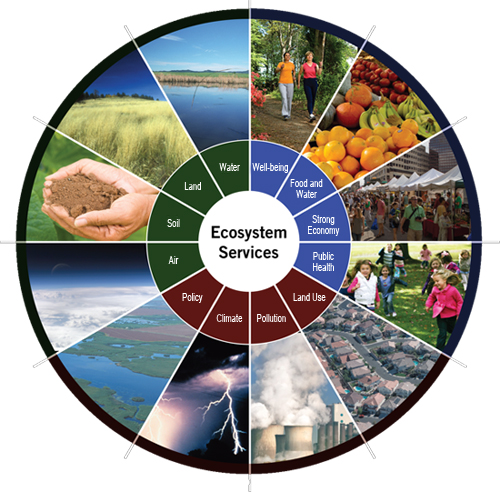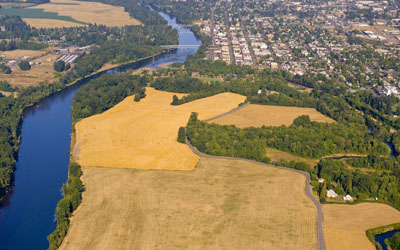
Ecosystem Services
- Home
- EPA Presentations
- Principles for Ecological Land Reuse
- Soil Science
- Soil Amendments
- Terrestrial Carbon Sequestration
- Plants and Revegetation
- Growing Gardens in Urban Soils
- Ecosystem Services
- Creating Pollinator Habitats as Part of an Ecological Revitalization Project
- Act Locally
- Land Revitalization Assistance
- Case Study Profiles
- Publications, Resources, and Links
- Glossary of Ecological Land Reuse Terms

What are ecosystem services?
Ecosystem Services are the life-sustaining products and benefits people obtain from natural environmental resources and processes, such as clean air and water, timber, and pollination of native and agricultural plants. Whether we find ourselves in the city or a rural area, the ecosystems in which humans live provide goods and services that are very familiar to us.
What are some common ecosystem services?

Drivers of Change. Source: EPA EnviroAtlas
- Climate regulation
- Purification of water and air
- Soil formation
- Carbon storage and sequestration
- Nutrient dispersal and cycling
- Seed dispersal
- Waste decomposition and detoxification
- Crop pollination
- Pest and disease control
- Food, crops, and spices
- Forest products (i.e. timber)
- Pharmaceuticals
- Energy (i.e. hydropower and biomass fuels)
- Recreation
- Scientific discovery and education
- Aesthetic and spiritual value
What is the role of soil and water in ecosystem services?
Soil is the building block of ecosystems — the medium in which all the living and non-living components of a system. Soil provides a physical, chemical, and biological environment for the exchange of water, nutrients, energy, and air, thereby supporting growth and diversity of plants, animals, and microorganisms. Water is the building block of life. It is essential for biological functions of all living organisms; ecosystems at the interface of land and water, particularly wetlands, provide services of critical importance to humans.
- Healthy soil regulates the distribution of water between infiltration and runoff; regulates the flow of water and solutes, including nutrients like nitrogen, phosphorus, and other dissolved constituents; and provides biological and chemical reactivity to degrade and/or immobilize toxic constituents.
- Degraded soil. The effects of soil degradation (e.g., compaction, mixing horizons, loss of topsoil) can include reduced water and gas transport, restrained root growth, increased runoff and erosion, reduced nutrient availability, less nutrient supply for essential microbes, increased transport of potentially toxic elements (e.g., heavy metals), and numerous other issues.
- Soil amendments can be used to restore and revitalize soils. One of the benefits of using organic soil amendments for remediation and ecological revitalization is carbon sequestration.
- Wetlands such as swamps, estuaries, and mangrove forests protect both human health and the environment by providing valuable services such as flood control in river environments, replenishing groundwater supplies, stabilizing shorelines and providing storm protection, and purifying water. Wetlands also serve as nurseries for many saltwater and freshwater fish and shellfish of commercial and recreational importance.
- Freshwater Ecosystems such as rivers, lakes, and streams provide invaluable services such as flood control, transportation, recreation, purification of human and industrial wastes, habitat for plants and animals, and production of fish and other foods and marketable goods. Rivers, lakes, wetlands and their connecting groundwater are the "sinks" into which landscapes drain, and are tightly linked to their respective watersheds.

Source: EPA Science Matters Newsletter
What impact do ecosystem services have on my health?
Ecosystem services are indispensable to the well-being of all people. From the growth of crops for food and supply of water, to regulation of vector-borne diseases, pests, and pathogens, human health and well-being depends on these services and conditions from the natural environment.
Human interventions such as overfishing, deforestation, and pollution are altering the capacity of ecosystems to provide their goods (e.g. fresh water, food, pharmaceutical products, etc.) and services (e.g. purification of air, water, soil, sequestration of pollutants, etc). Ecosystem disruption can impact human health in a variety of ways and through complex pathways. The types of health effects experienced are determined by the degree to which local populations depend on ecosystem services, and factors such as poverty that affect vulnerability to changes in elements such as access to food and water.
For in-depth information on the complex links between ecosystems and human health, please visit the EPA Eco-Health Relationship Browser.
What is the value of ecosystem services?
Expressing the value of ecosystem services quantitative economic units can be a useful tool for illustrating the fundamental importance of healthy ecosystems for human health and well-being. Value, however, is not a single, simple concept. People have material, moral, spiritual, aesthetic, cultural and other interests, all of which can affect their perception of the value of ecosystems and the services they provide. The value of ecological systems and services can be viewed from many perspectives, including ecological, economic, philosophical, and psychological.
Ecosystems provide humans with services that would be very difficult to duplicate in an artificial environment. Placing an accurate monetary amount on ecosystem services is very difficult, but some researchers have attempted to make quantitative estimates. A 2012 Study, Global Estimates of the Value of Ecosystems and their Services in Monetary Units, estimated over 1,300 unique values for services provided by different ecosystems and biomes. While the values were estimated in the trillions of dollars, the researchers strongly cautioned that these estimates should not be used to consider ecosystem services as tradable, monetary commodities. Instead, the numbers should be used to highlight their benefits to society and to humankind - benefits that would be lost if the ecosystem is destroyed, and benefits that would be gained if the ecosystems are restored and protected.
Similarly, a 2009 Report by the EPA Science Advisory Board, Valuing the Protection of Ecological Systems and Services, recognizes that the valuation of ecosystem services can be an important tool in guiding policy, setting program priorities, and helping EPA improve the remediation of hazardous waste sites and making other site-specific decisions.
Examples of Ecosystem Services at Work
- The New York City Watershed provides safe drinking water for the city's 9 million residents. Rather than build a filtration plant for this water, the City preserves the land and ecosystems within the watershed, resulting in low costs and some of the purest drinking water on the planet.
- An EPA study that considered the value of ecosystem services in the Chesapeake Bay Watershed found that these can be a powerful tool when determining pollution prevention strategies that address national guidance and policy.
- Reuse activities at the Northwest 58th Street Landfill Superfund Site in Miami, Florida truly took into account the services the ecosystem can provide. The landfill operated from 1952-1982. In its last three years, it operated as an unpermitted sanitary landfill. Leachate from the landfill contaminated the Biscayne Aquifer beneath and adjacent to the site. Remediation included groundwater treatment with air stripping and capping to a level protective of human health and the environment, but included an eye towards ecological reuse as well. Several onsite wetlands were restored as part of the remedial process, providing habitat for animals such as the endangered wood storks. Lookout centers with a trail system were also included to allow the community access to view the restored habitat and return of wildlife to the property.
Additional Resources
- Ecosystem Services at Contaminated Site Cleanups
The purpose of this issue paper is to provide cleanup site teams with information about ecosystem services. These concepts and tools are useful in communicating the positive results of cleanup in addition to achieving the goals of cleanup. Information about ecosystem services may be considered in characterization of future land use options or design of a cleanup that is consistent with anticipated ecological reuse, depending on the regulatory authority of the cleanup program. - Understanding Ecosystem Services at Superfund Cleanups
The purpose of this report is to help representatives of the Superfund program understand ecosystem services (ES) and their relevance to greener cleanups at contaminated sites. The discussion focuses on the use of ES evaluations to support greener cleanups and related environmental footprint analyses. It describes ES evaluation tools, as well as greener cleanups best management practices to minimize impacts of site cleanup on ES and to support land reuse. In addition, the paper describes the relationship of ES to other site-related activities. - Ecosystem Services at Superfund Sites
New or restored ecosystems on Superfund sites can generate important economic benefits by providing services like timber, water purification, and recreation opportunities. This document explores how ecosystems generate economic benefits, and provides examples of ecosystem services at Superfund sites across the country. - EPA Ecosystem Services
General information on EPA research and resources on ecosystem services. - EPA EnviroAtlas
EnviroAtlas is a collection of interactive tools and resources that allows users to explore the many benefits people receive from nature. - EPA Eco-Health Relationship Browser
The Eco-Health Relationship Browser illustrates scientific evidence for linkages between human health and ecosystem services–benefits supplied by Nature. This interactive tool provides information about several of our nation's major ecosystems, the services they provide, and how those services, or their degradation and loss, may affect people. - Ecological Society of America — Ecosystem Services Fact Sheet
An easy-to-read fact sheet on ecosystem services intended for general audiences. - Ecosystem Services — NOAA Habitat Conservation
This page describes the role of the NOAA Habitat Conservation program in protecting the ecosystem services of coastal and marine resources. - Ecosystem Services at Contaminated Site Cleanups
The purpose of this issue paper is to provide cleanup site teams with information about ecosystem services. These concepts and tools are useful in communicating the positive results of cleanup in addition to achieving the goals of cleanup. Information about ecosystem services may be considered in characterization of future land use options or design of a cleanup that is consistent with anticipated ecological reuse, depending on the regulatory authority of the cleanup program. - The Federal Resource Management and Ecosystem Services Guidebook
This guidebook serves as a training manual that helps to streamline the management of ecosystem services. With the guidebook, resource managers can create clear, workable plans that prioritize the work needed to establish and maintain resilient communities throughout the country. - General Ecological Assessment Endpoints for Ecological Risk Assessment (2nd Edition)
This document builds on existing EPA guidance and experience to assist those who are involved in ecological risk assessment in considering ecosystem services when selecting assessment endpoints. Incorporating ecosystem services endpoints in ecological risk assessments can make the assessments relevant to decision makers and stakeholders whose concerns may be more oriented toward societal outcomes. - US Forest Service — Ecosystem Services
The US Forest Service is exploring national opportunities to advance markets and payments for ecosystem services. This site describes their current efforts and the role of the new Office of Environmental Markets, which has a goal of exploring market-based approaches to environmental conservation. - United Nations Millennium Ecosystem Assessment
Initiated in 2001, the objective of the Millennium Ecosystem Assessment (MA) was to assess the consequences of ecosystem change for human well-being and the scientific basis for action needed to enhance the conservation and sustainable use of those systems and their contribution to human well-being. The MA has involved the work of more than 1,360 experts worldwide. Its findings provide a state-of-the-art scientific appraisal of the condition and trends in the world's ecosystems, the services they provide, and the options to restore, conserve or enhance the sustainable use of ecosystems. - SolVES 3.0 Software — The U.S. Geological Survey has released the solVES 3.0 software. SolVES is a geographic information system tool that is designed to assess, map, and quantify the social values of ecosystem services. Social values — the perceived, nonmarket values the public ascribes to ecosystem services, particularly cultural services, such as aesthetics and recreation — can be evaluated for various stakeholder groups (e.g., motorized recreation). The tool also calculates metrics characterizing the underlying environment, such as average distance to water and dominant landcover. SolVES 3.0 provides an improved public-domain tool for decision makers and researchers to evaluate the social values of ecosystem services and to facilitate discussions among diverse stakeholders regarding the tradeoffs among ecosystem services in a variety of physical and social contexts, ranging from forest and rangeland to coastal and marine.




